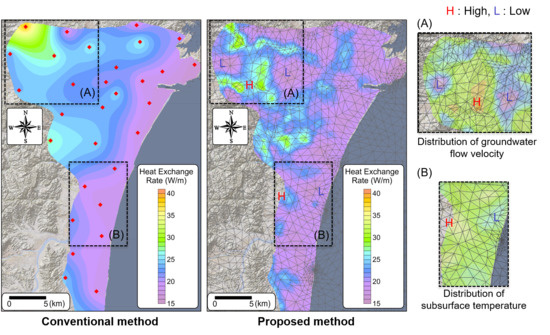Proposal for a Method Predicting Suitable Areas for Installation of Ground-Source Heat Pump Systems Based on Response Surface Methodology
Abstract
:1. Introduction
2. Review of Hydrogeological Information and Numerical Simulation of the Study Area
3. Study Methods
3.1. Response Surface Methodology
3.2. Examination of the Average Method
3.2.1. Groundwater Flow Velocity
3.2.2. Subsurface Temperature
3.2.3. Thermal Conductivity
3.3. Creation of Estimation Formula for the HER
4. Application of the Estimation Formula for the HER to the Sendai Plain
5. Validation of the Estimation Formula by Constructing GHE Models
6. Discussion
7. Conclusions
- (1)
- It was found that the main factors affecting the HER were groundwater flow velocity (), subsurface temperature (), and thermal conductivity of solids ().
- (2)
- The average method in the vertical direction (GHE length) was evaluated. and can be calculated by arithmetic averaging. In contrast, has to be calculated as a combination of arithmetic and harmonic average.
- (3)
- The RSM was utilized to approximate the HER using the three parameters in the Sendai Plain. The estimated HER agreed well with the calculated one by the GHE models because the coefficient of determination and RMSE between the two HERs were 0.999 and 0.129, respectively.
- (4)
- The proposed method cannot only estimate the HER from hydrogeological parameters in an easy way but also highly increase the spatial resolution of a map by creating a GHE model without performing heat exchange simulations.
Author Contributions
Funding
Acknowledgments
Conflicts of Interest
Abbreviations
| 3D | Three-dimensional |
| GSHP | Ground source heat pump |
| GHE | Ground heat exchanger |
| HER | Heat exchange rate |
| RSM | Response surface methodology |
| 3D | Three-dimensional |
| Groundwater flow velocity | |
| Subsurface temperature | |
| Thermal conductivity of the solid | |
| Heat exchange rate | |
| to | Regression coefficients |
| Average groundwater flow velocity | |
| , | Parameters that vary with arithmetic average groundwater flow velocity |
| Arithmetic average groundwater flow velocity | |
| Harmonic average groundwater flow velocity |
References
- Fujii, H.; Inatomi, T.; Itoi, R.; Uchida, Y. Development of suitability maps for ground-coupled heat pump systems using groundwater and heat transport models. Geothermics 2007, 36, 459–472. [Google Scholar] [CrossRef]
- Mustafa Omer, A. Ground-source heat pumps systems and applications. Renew. Sustain. Energy Rev. 2008, 12, 344–371. [Google Scholar] [CrossRef]
- Wagner, V.; Bayer, P.; Kübert, M.; Blum, P. Numerical sensitivity study of thermal response tests. Renew. Energy 2012, 41, 245–253. [Google Scholar] [CrossRef]
- Self, S.J.; Reddy, B.V.; Rosen, M.A. Geothermal heat pump systems: Status review and comparison with other heating options. Appl. Energy 2013, 101, 341–348. [Google Scholar] [CrossRef]
- Ozgener, O.; Hepbasli, A. Modeling and performance evaluation of ground source (geothermal) heat pump systems. Energy Build. 2007, 39, 66–75. [Google Scholar] [CrossRef]
- Salvalai, G. Implementation and validation of simplified heat pump model in IDA-ICE energy simulation environment. Energy Build. 2012, 49, 132–141. [Google Scholar] [CrossRef]
- Perego, R.; Guandalini, R.; Fumagalli, L.; Aghib, F.S.; De Biase, L.; Bonomi, T. Sustainability evaluation of a medium scale GSHP system in a layered alluvial setting using 3D modeling suite. Geothermics 2016, 59, 14–26. [Google Scholar] [CrossRef]
- Dalla Santa, G.; Galgaro, A.; Sassi, R.; Cultrera, M.; Scotton, P.; Mueller, J.; Bertermann, D.; Mendrinos, D.; Pasquali, R.; Perego, R.; et al. An updated ground thermal properties database for GSHP applications. Geothermics 2020, 85, 101758. [Google Scholar] [CrossRef]
- Han, C.; Yu, X. Sensitivity analysis of a vertical geothermal heat pump system. Appl. Energy 2016, 170, 148–160. [Google Scholar] [CrossRef] [Green Version]
- Li, C.; Cleall, P.J.; Mao, J.; Muñoz-Criollo, J.J. Numerical simulation of ground source heat pump systems considering unsaturated soil properties and groundwater flow. Appl. Therm. Eng. 2018, 139, 307–316. [Google Scholar] [CrossRef]
- Cheap-Gshps Cheap and Efficient Application of Reliable Ground Source Heat Exchangers and Pumps. Available online: https://cheap-gshp.eu/ (accessed on 25 February 2020).
- Luo, J.; Luo, Z.; Xie, J.; Xia, D.; Huang, W.; Shao, H. Investigation of shallow geothermal potentials for different types of ground source heat pump systems (GSHP) of Wuhan city in China. Renew. Energy 2018, 118, 230–244. [Google Scholar] [CrossRef]
- Shrestha, G.; Uchida, Y.; Yoshioka, M.; Fujii, H.; Ioka, S. Assessment of development potential of ground-coupled heat pump system in Tsugaru Plain, Japan. Renew. Energy 2015, 76, 249–257. [Google Scholar] [CrossRef]
- Shrestha, G.; Uchida, Y.; Kuronuma, S.; Yamaya, M.; Katsuragi, M.; Kaneko, S.; Shibasaki, N.; Yoshioka, M. Performance evaluation of a ground-source heat pump system utilizing a flowing well and estimation of suitable areas for its installation in Aizu Basin, Japan. Hydrogeol. J. 2017, 25, 1437–1450. [Google Scholar] [CrossRef]
- Fujii, H.; Itoi, R.; Fujii, J.; Uchida, Y. Optimizing the design of large-scale ground-coupled heat pump systems using groundwater and heat transport modeling. Geothermics 2005, 34, 347–364. [Google Scholar] [CrossRef]
- Zanchini, E.; Lazzari, S.; Priarone, A. Long-term performance of large borehole heat exchanger fields with unbalanced seasonal loads and groundwater flow. Energy 2012, 38, 66–77. [Google Scholar] [CrossRef]
- Choi, J.C.; Park, J.; Lee, S.R. Numerical evaluation of the effects of groundwater flow on borehole heat exchanger arrays. Renew. Energy 2013, 52, 230–240. [Google Scholar] [CrossRef]
- Dehkordi, S.E.; Schincariol, R.A. Effect of thermal-hydrogeological and borehole heat exchanger properties on performance and impact of vertical closed-loop geothermal heat pump systems. Hydrogeol. J. 2014, 22, 189–203. [Google Scholar] [CrossRef]
- Casasso, A.; Sethi, R. Efficiency of closed loop geothermal heat pumps: A sensitivity analysis. Renew. Energy 2014, 62, 737–746. [Google Scholar] [CrossRef] [Green Version]
- Environmental Management Bureau, Government of Japan. Ministry of the Environment Results of a Survey on the Installation Conditions of Ground-Source Heat Pump Systems. Available online: http://www.env.go.jp/press/106636.html (accessed on 25 February 2020). (In Japanese)
- Kaneko, S.; Uchida, Y.; Shrestha, G.; Ishihara, T.; Yoshioka, M. Factors affecting the installation potential of ground source heat pump systems: A comparative study for the Sendai plain and Aizu basin, Japan. Energies 2018, 11, 2860. [Google Scholar] [CrossRef] [Green Version]
- Diersch, H.-J.G. FEFLOW—Finite Element Modeling of Flow, Mass and Heat Transport in Porous and Fractured Media; Springer: Berlin/Heidelberg, Germany, 2014; ISBN 978-3-642-38738-8. [Google Scholar]
- Tomigashi, A.; Nishiyama, K.; Yamamoto, A.; Dan, T.; Takahashi, T. Proposal of method evaluating installation potential of ground source heat pump systems in regional area. In Proceedings of the 2013 spring meeting Japanese Association of Groundwater Hydrology Abstracts with Programs, Chiba, Japan, 18 May 2013; pp. 104–109. (In Japanese). [Google Scholar]
- Vu-Bac, N.; Lahmer, T.; Zhuang, X.; Nguyen-Thoi, T.; Rabczuk, T. A software framework for probabilistic sensitivity analysis for computationally expensive models. Adv. Eng. Softw. 2016, 100, 19–31. [Google Scholar] [CrossRef]
- Smith, L.; Chapman, D.S. On the thermal effects of groundwater flow, 1. Regional scale systems. J. Geophys. Res. 1983, 88, 593–608. [Google Scholar] [CrossRef]
- Anderson, M.P. Heat as a ground water tracer. Ground Water 2005, 43, 951–968. [Google Scholar] [CrossRef] [PubMed]
- Saar, M.O. Review: Geothermal heat as a tracer of large-scale groundwater flow and as a means to determine permeability fields. Hydrogeol. J. 2011, 19, 31–52. [Google Scholar] [CrossRef]
- Alcaraz, M.; García-Gil, A.; Vázquez-Suñé, E.; Velasco, V. Advection and dispersion heat transport mechanisms in the quantification of shallow geothermal resources and associated environmental impacts. Sci. Total Environ. 2016, 543, 536–546. [Google Scholar] [CrossRef]
- Majumder, R.K.; Shimada, J.; Taniguchi, M. Groundwater flow systems in the Bengal Delta, Bangladesh, inferred from subsurface temperature readings. Songklanakarin J. Sci. Technol. 2013, 35, 99–106. [Google Scholar]
- Domenico, P.A.; Palciauskas, V.V. Theoretical analysis of forced convective heat transfer in regional ground-water flow. Bull. Geol. Soc. Am. 1973, 84, 3803–3814. [Google Scholar] [CrossRef]
- Taniguchi, M.; Williamson, D.R.; Peck, A.J. Disturbances of temperature-depth profiles due to surface climate change and subsurface water flow: 2. An effect of step increase in surface temperature caused by forest clearing in southwest Western Australia. Water Resour. Res. 1999, 35, 1519–1529. [Google Scholar] [CrossRef]
- Parsons, M.L. Groundwater thermal regime in a glacial complex. Water Resour. Res. 1970, 6, 1701–1720. [Google Scholar] [CrossRef]
- Yasukawa, K.; Uchida, Y.; Tenma, N.; Taguchi, Y.; Muraoka, H.; Ishii, T.; Suwanlert, J.; Buapeng, S.; Nguyen, T.H. Groundwater temperature survey for geothermal heat pump application in tropical Asia. Bull. Geol. Surv. Japan 2009, 60, 459–467. [Google Scholar] [CrossRef]
- Domenico, P.A.; Schwartz, F.W. Physical and Chemical Hydrogeology; John Wiley & Sons, Inc.: Hoboken, NJ, USA, 1990. [Google Scholar]
- Shrestha, G.; Uchida, Y.; Ishihara, T.; Kaneko, S.; Kuronuma, S. Assessment of the installation potential of a ground source heat pump system based on the groundwater condition in the Aizu Basin, Japan. Energies 2018, 11, 1178. [Google Scholar] [CrossRef] [Green Version]
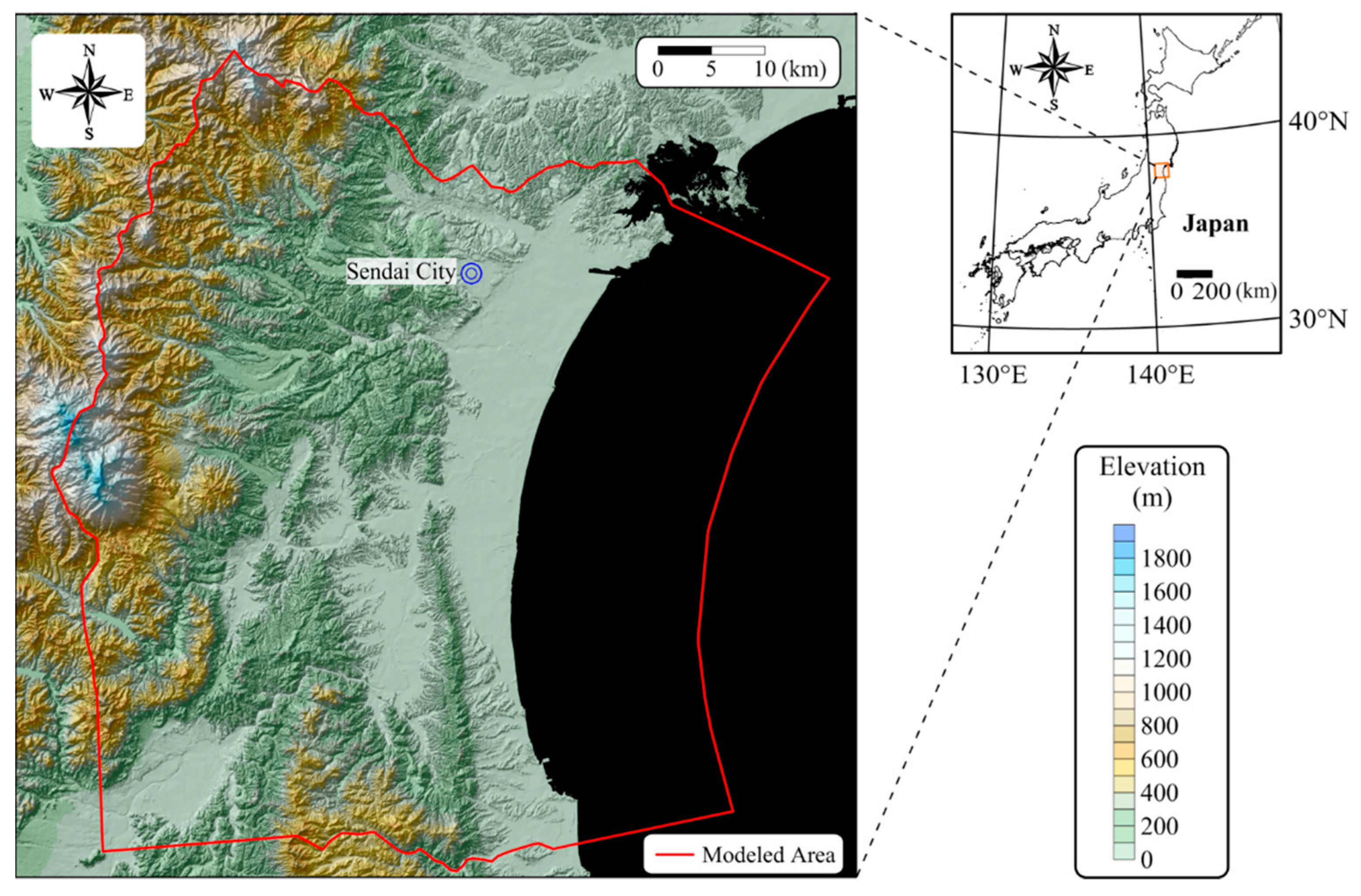
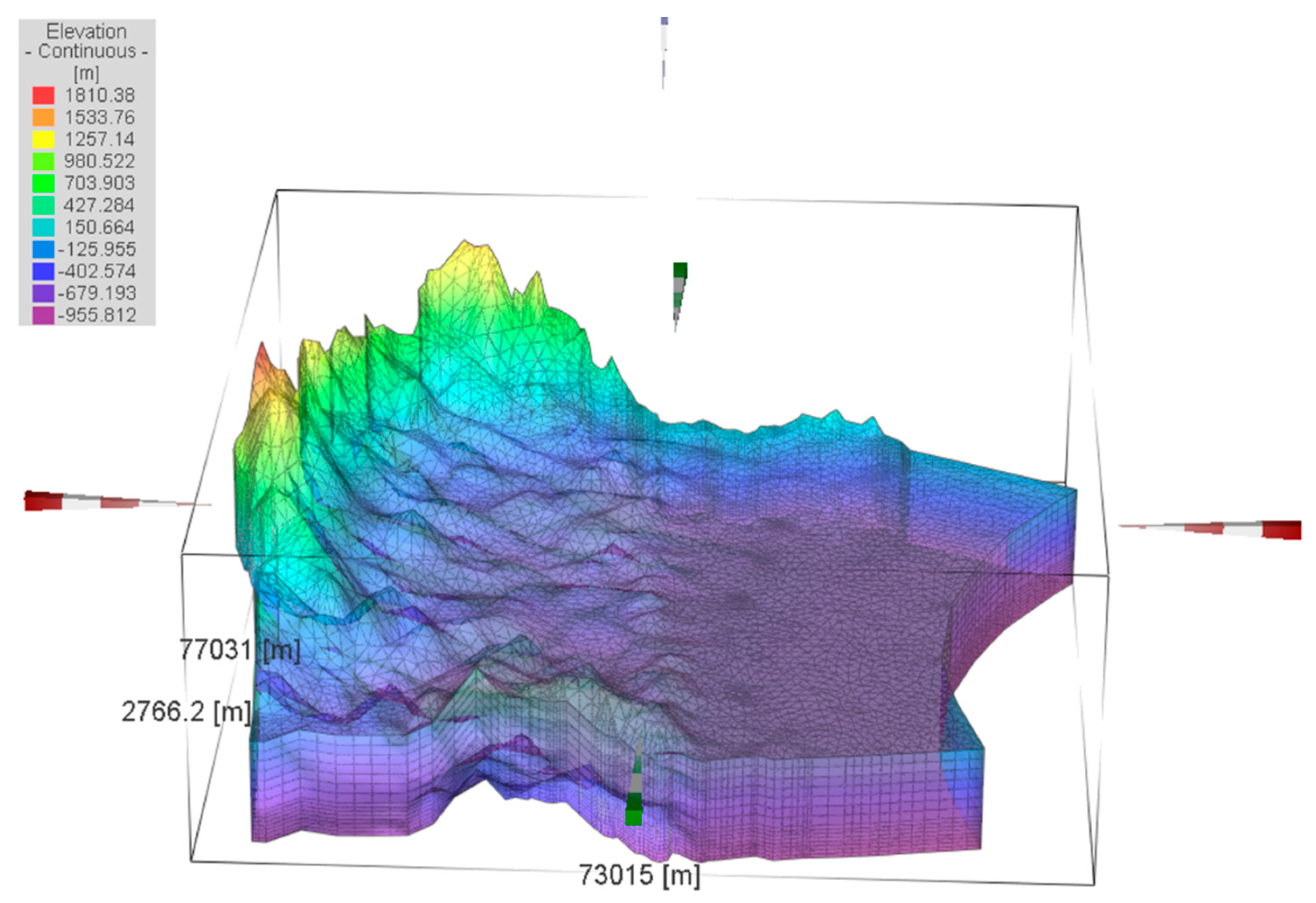
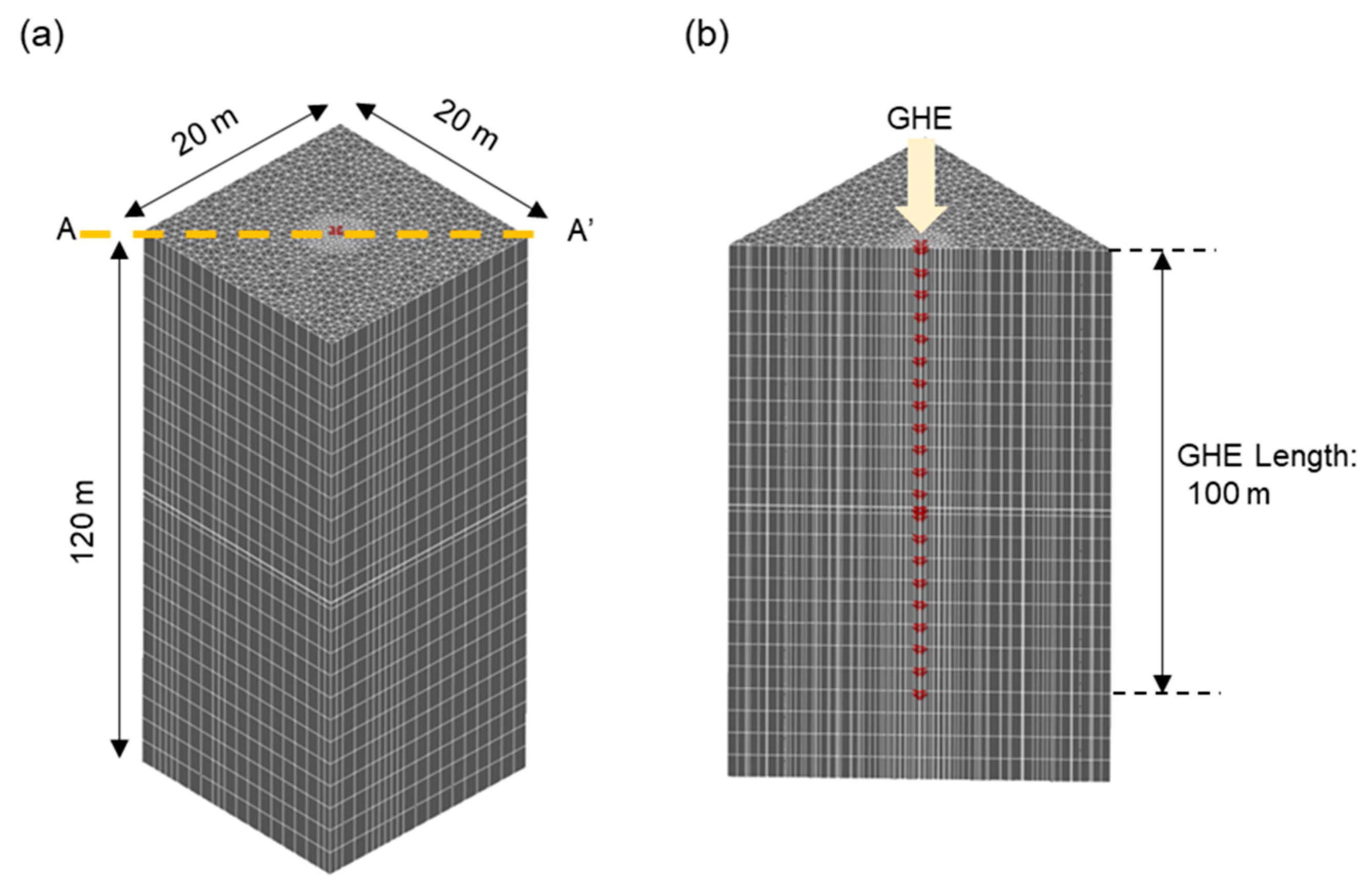
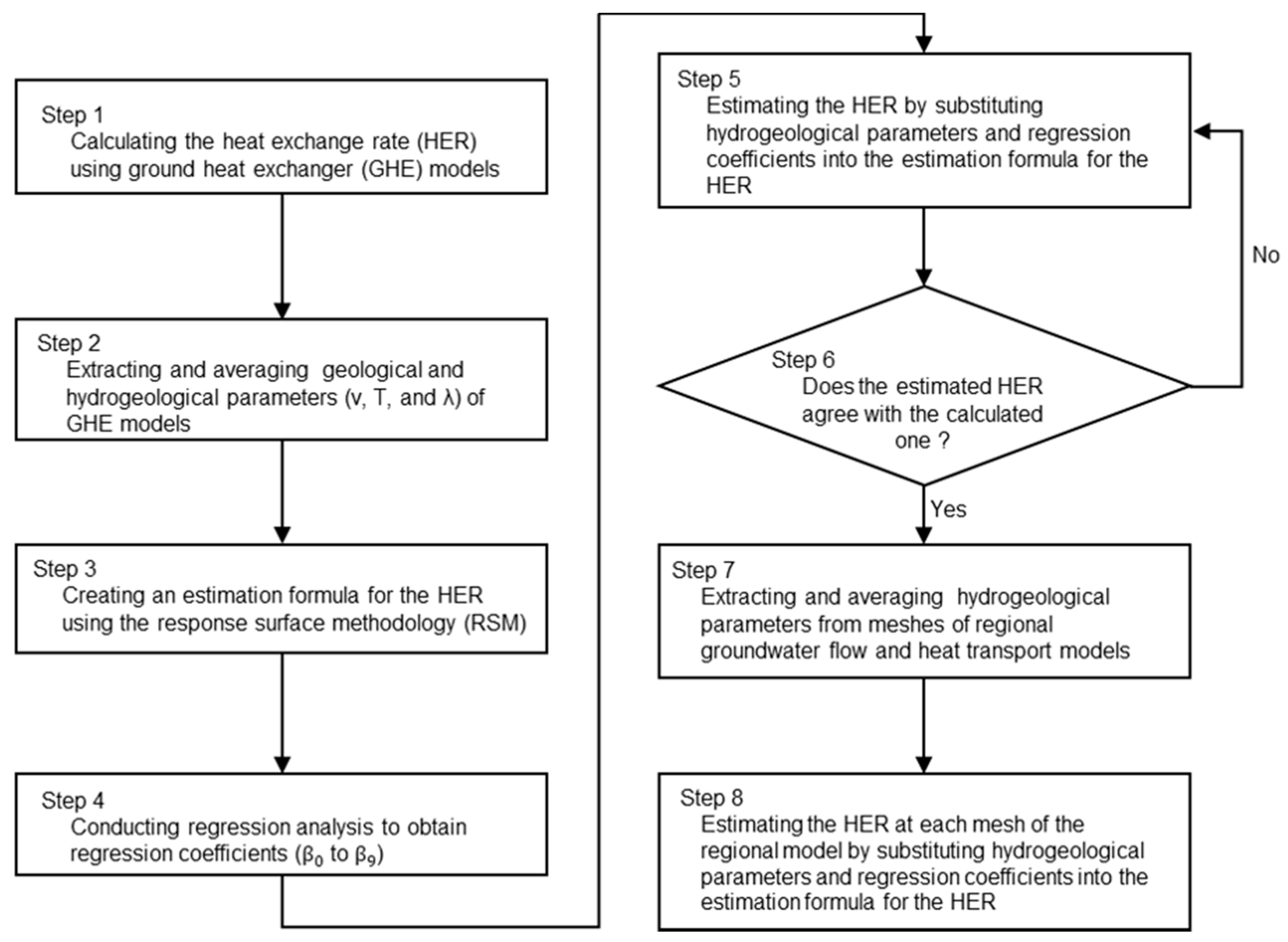
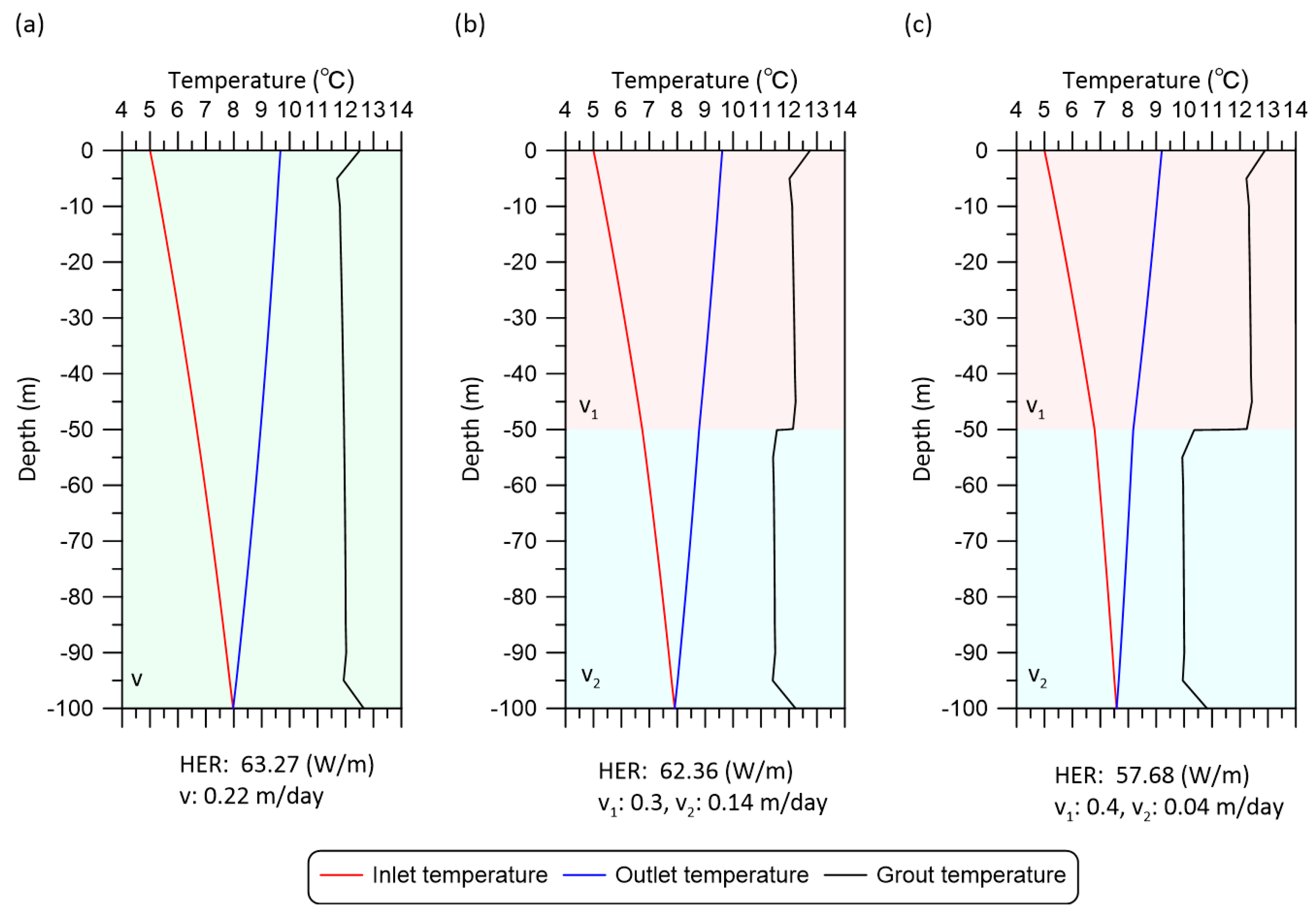
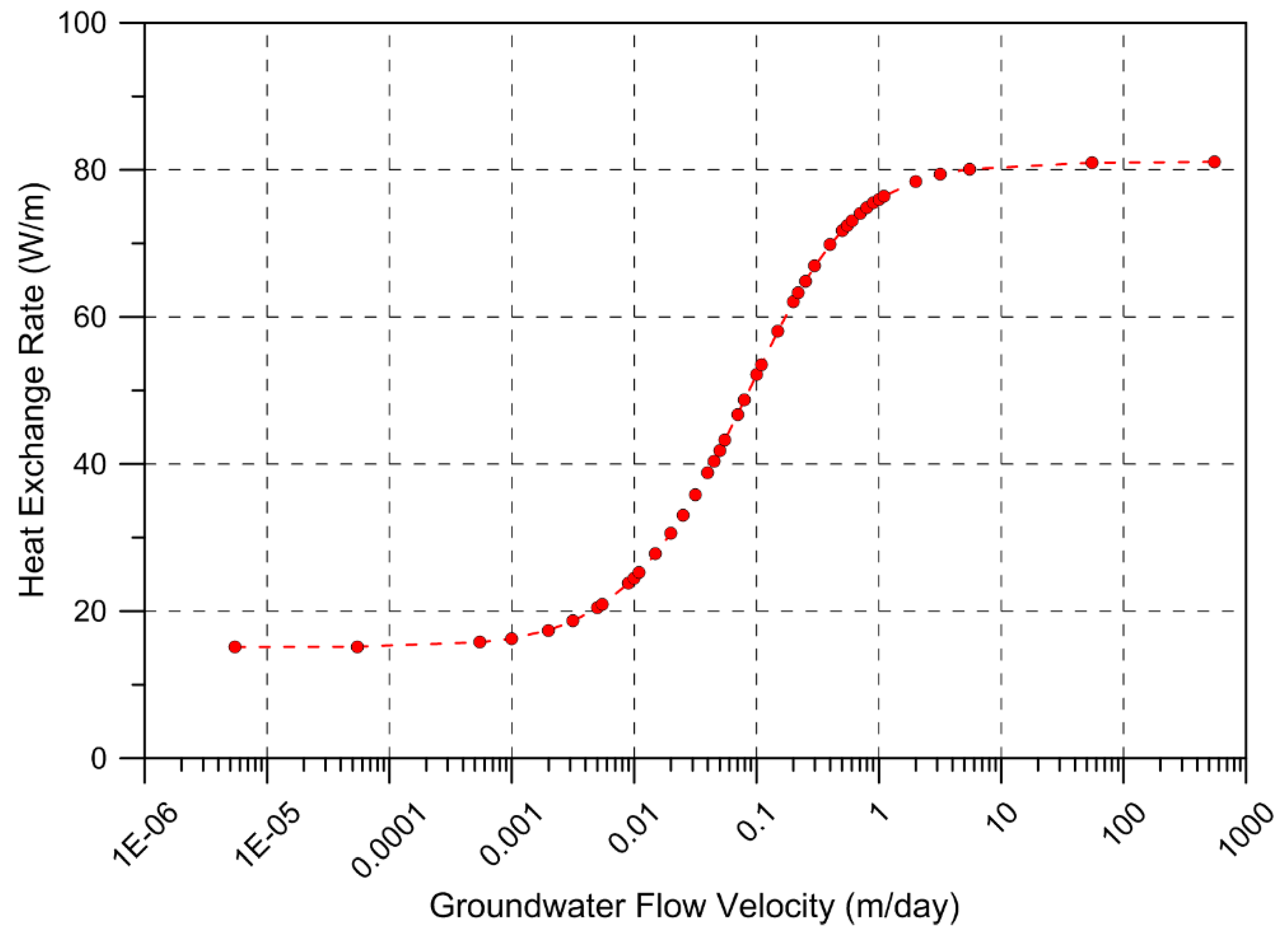
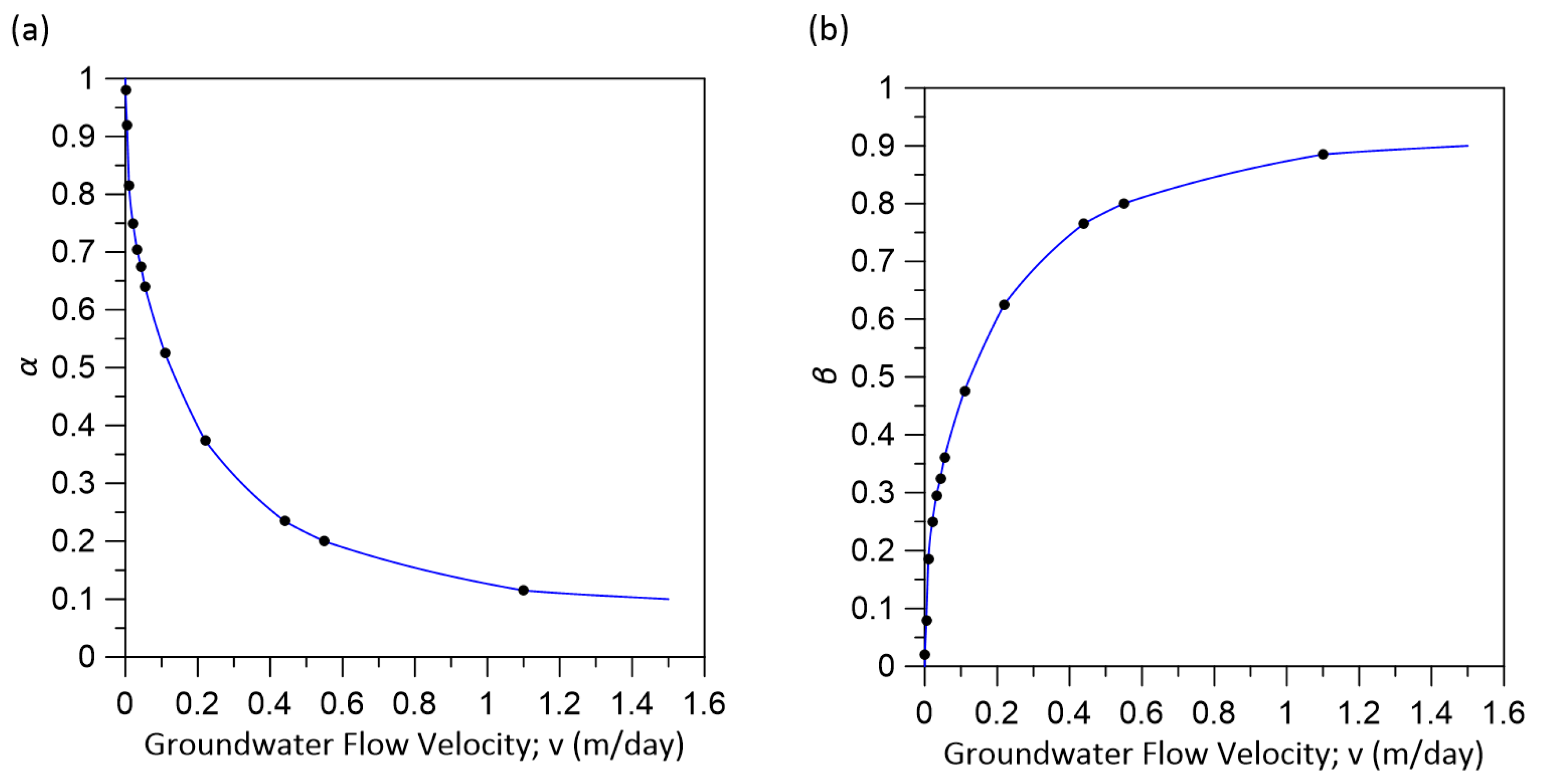
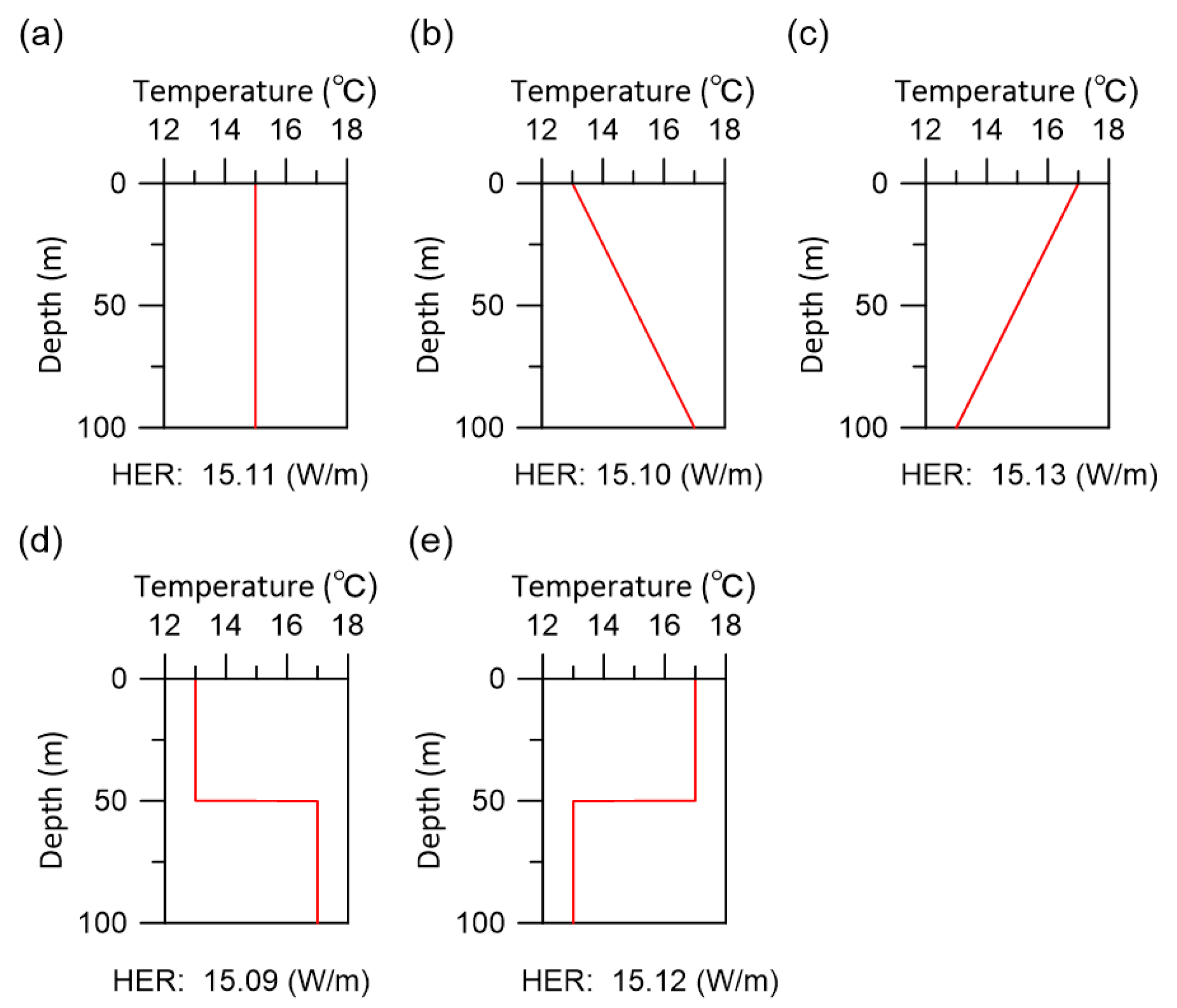

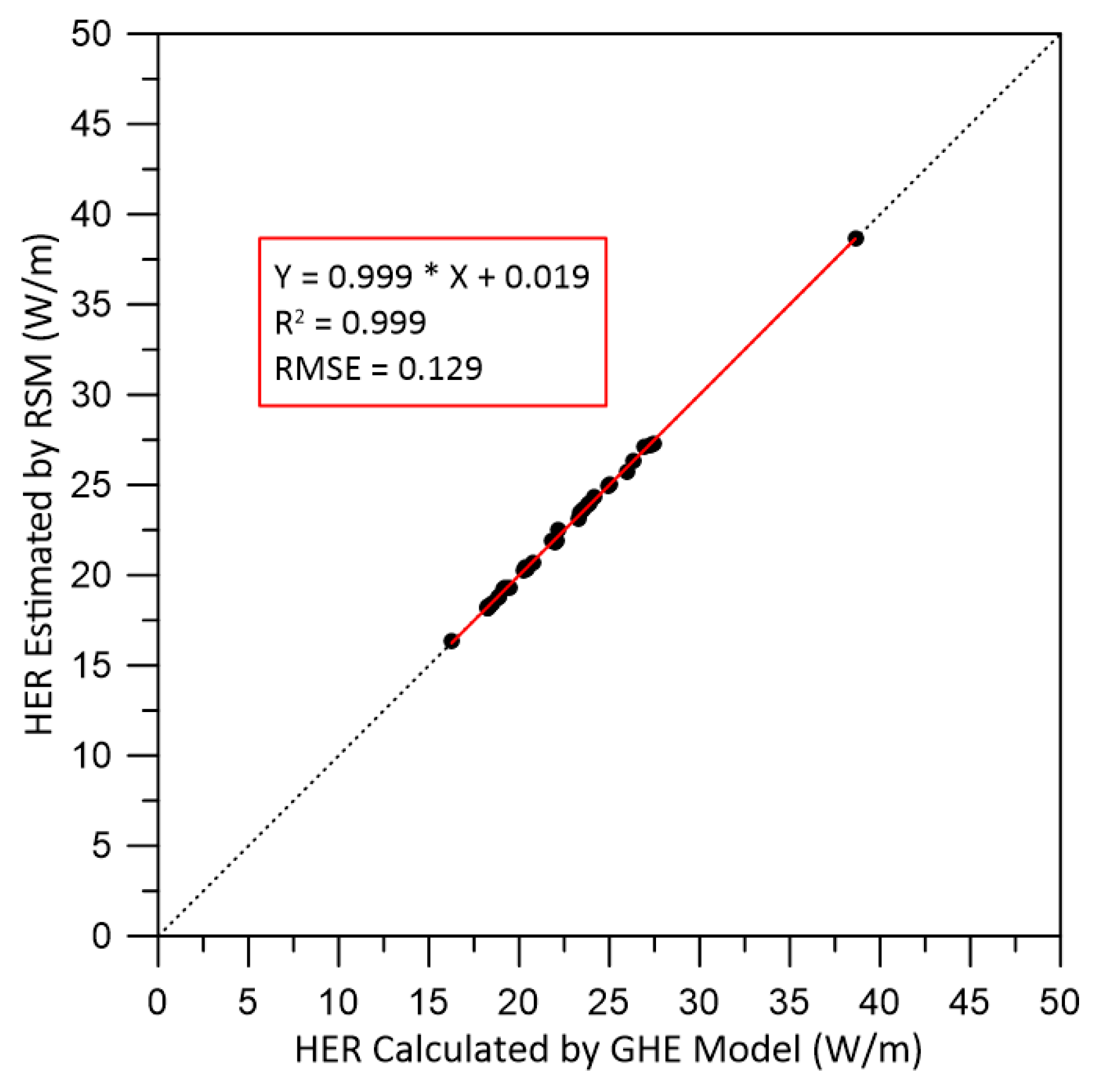
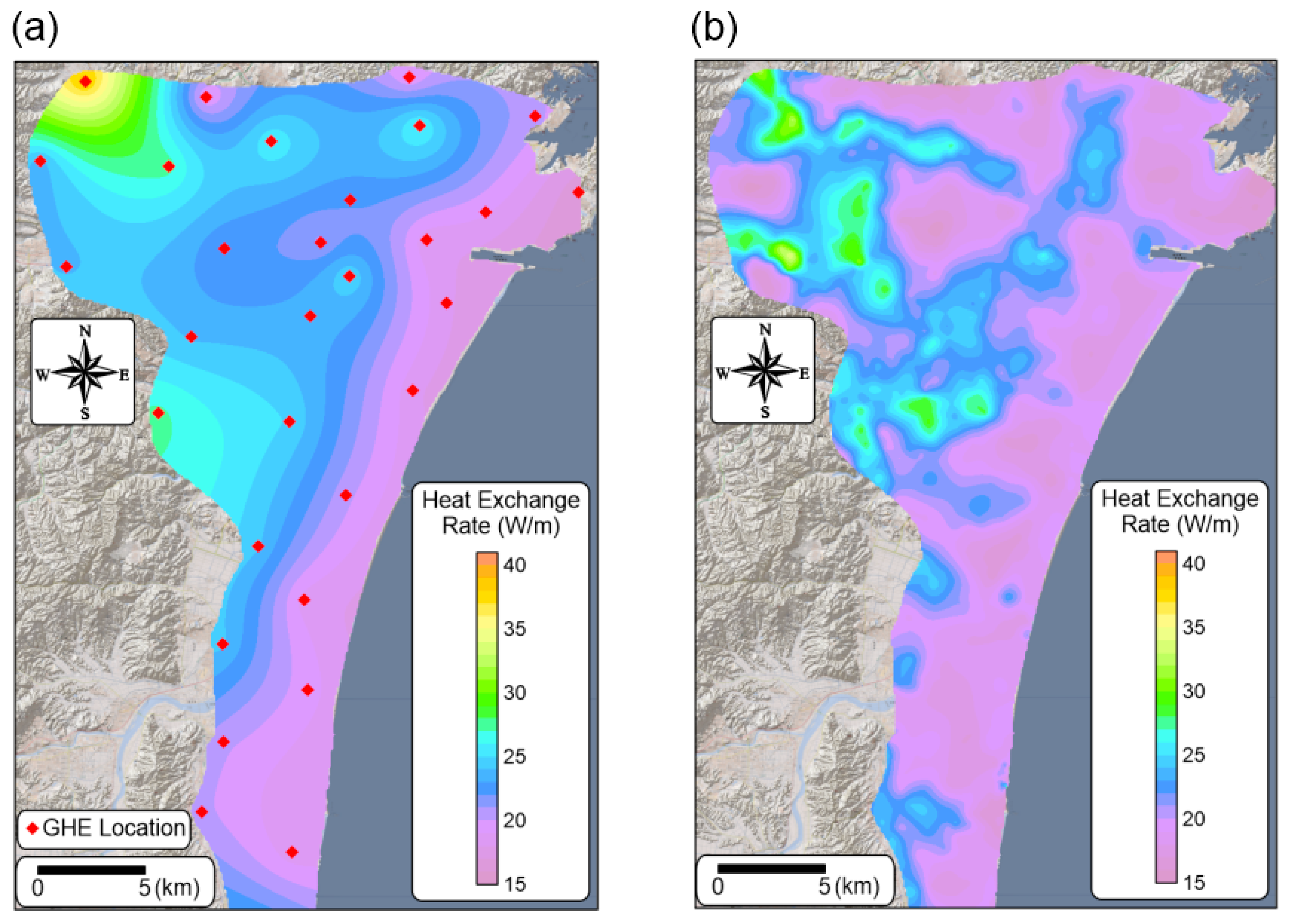
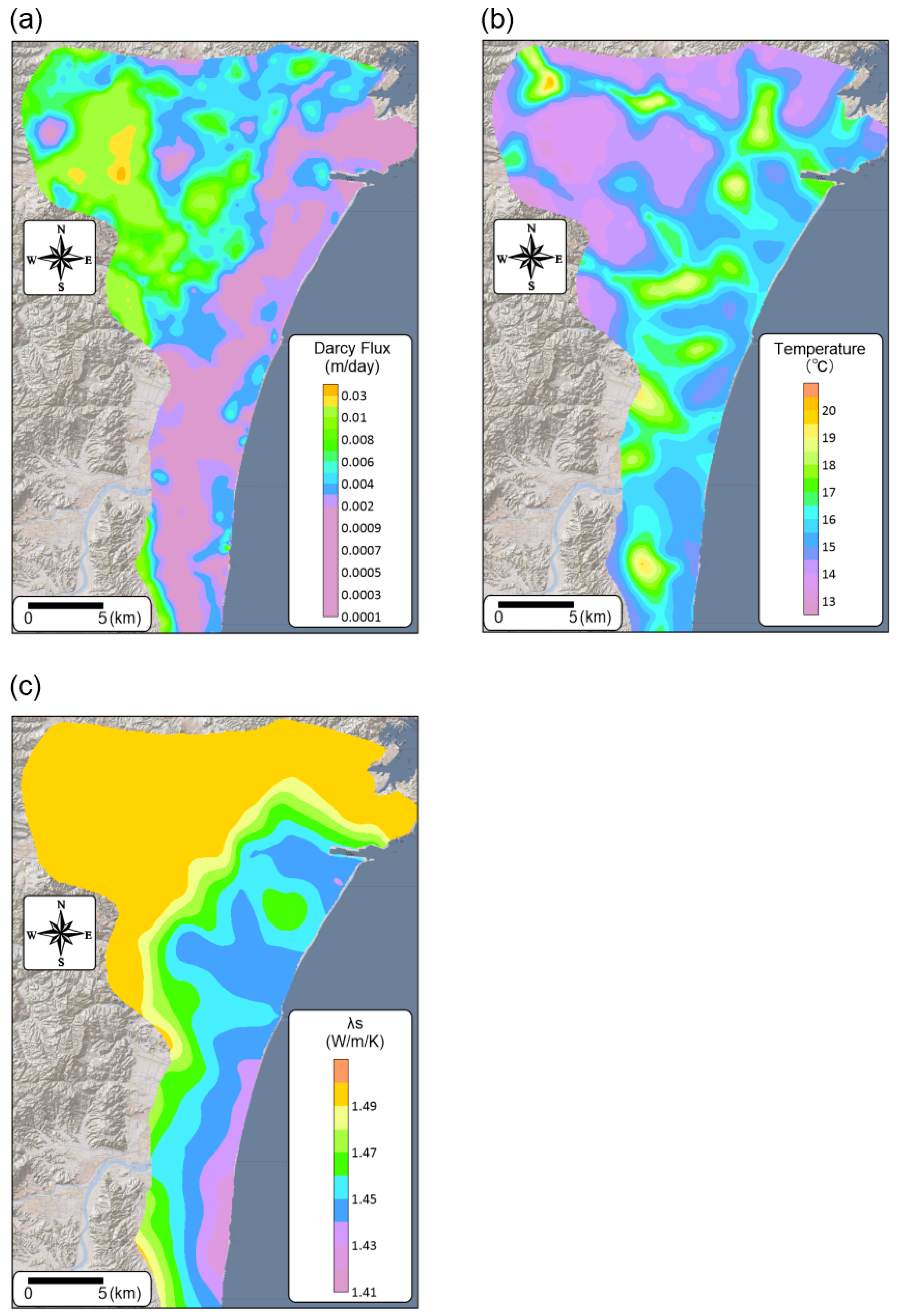
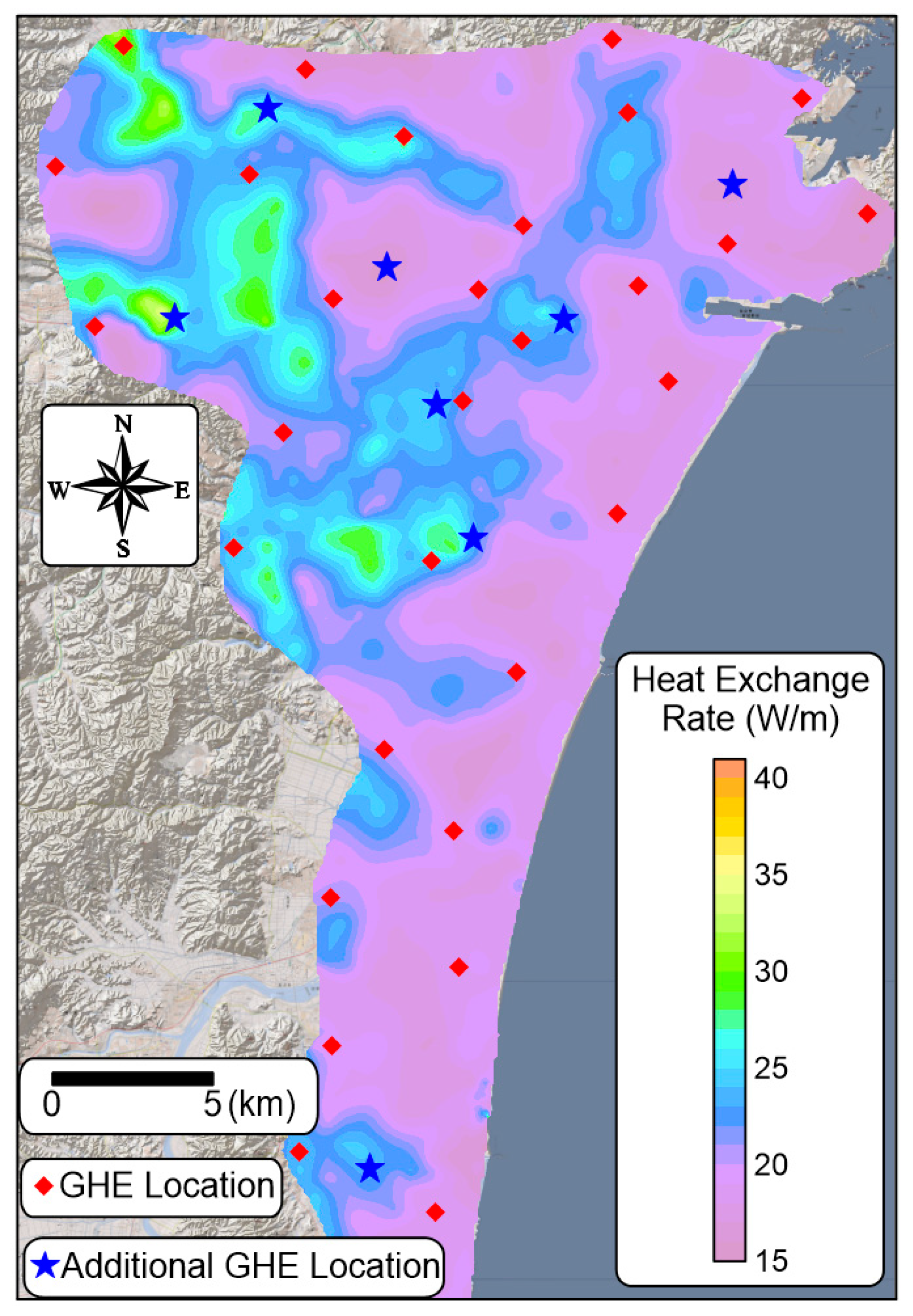
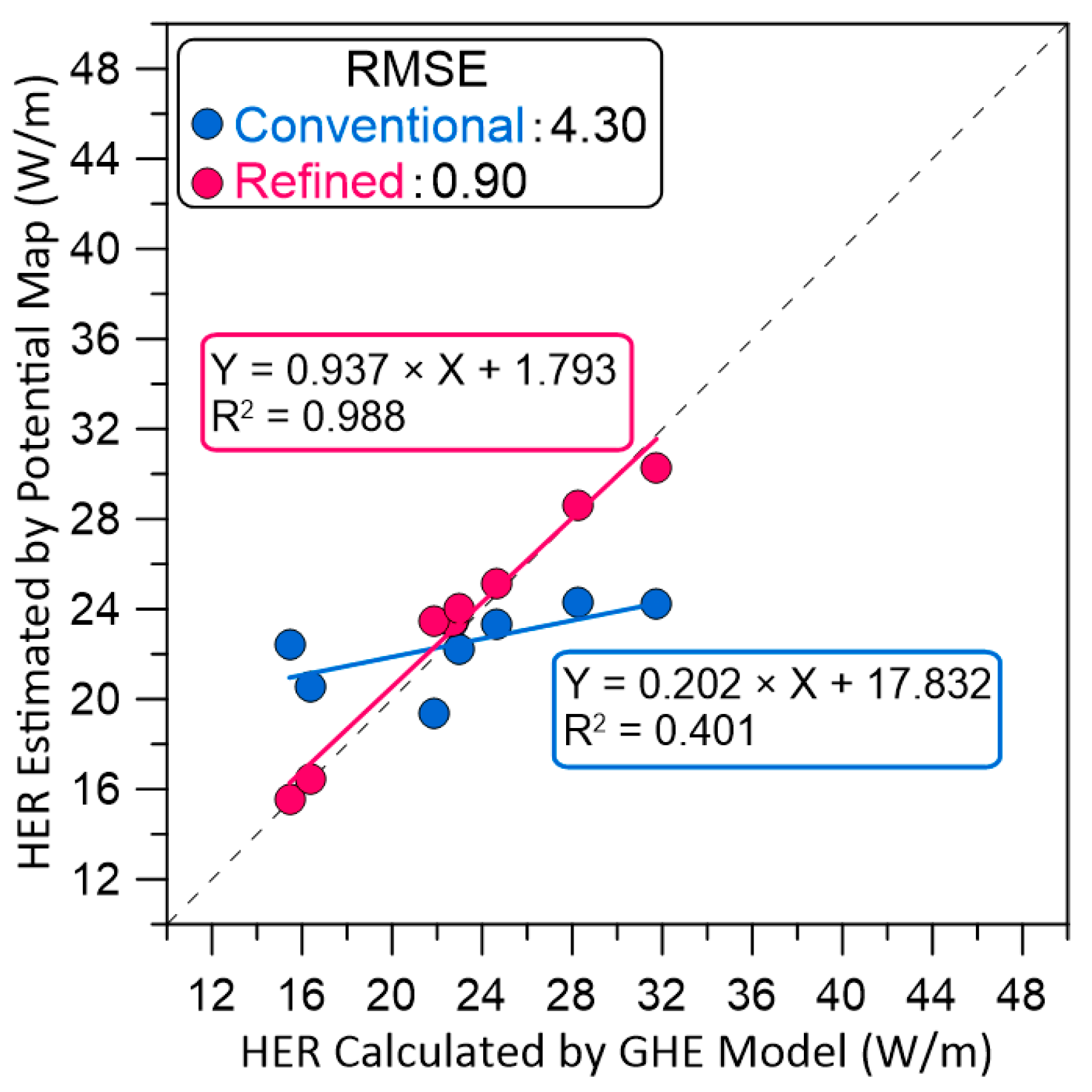
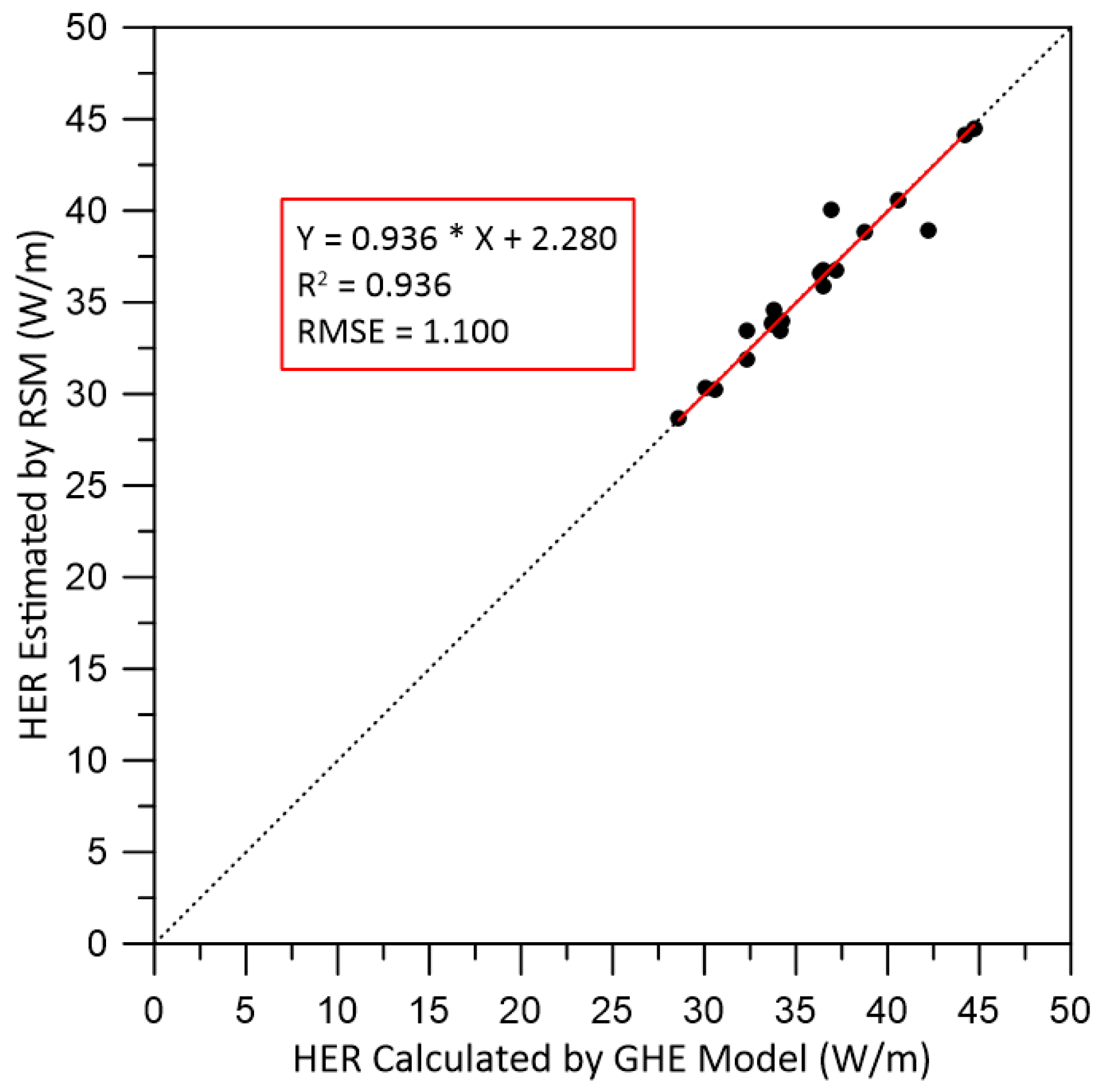
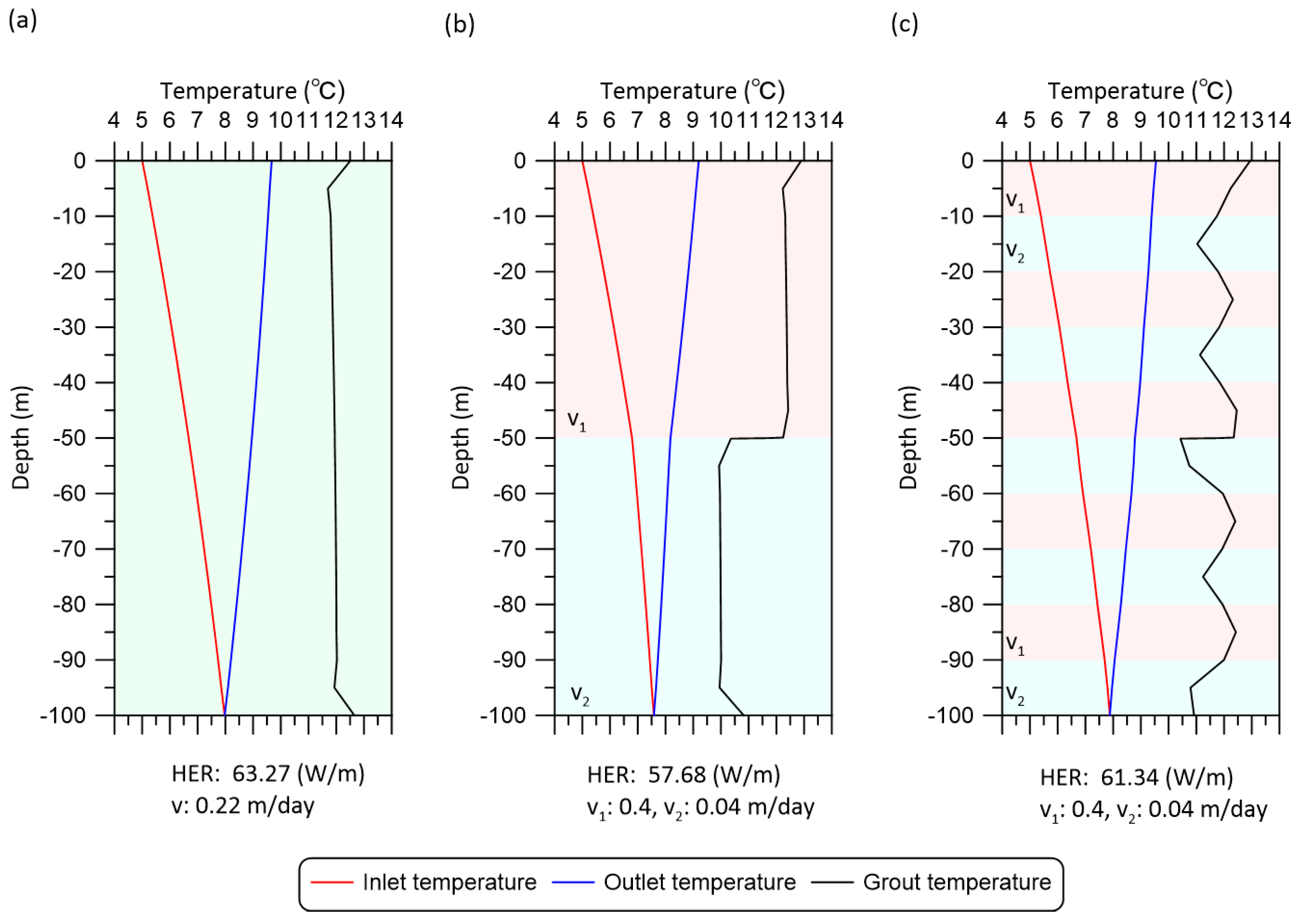
| Layer | Formation (Thickness of the Formation (m)) | Horizontal Hydraulic Conductivity (m/Day) | Vertical Hydraulic Conductivity (m/Day) | Porosity (−) | Thermal Conductivity of Solids (W/m/K) |
|---|---|---|---|---|---|
| 1–2 | Quaternary (<80 m) | 5.0 | 2.5 | 0.2 | 1.4 |
| 3–9 | Upper Neogene (540–620 m) | 0.4 | 0.2 | 0.1 | 1.5 |
| 10–17 | Lower Neogene (300 m) | 0.08 | 0.04 | 0.1 | 1.8 |
| 0 | 1 | 0 |
| 0.0011 | 0.98 | 0.02 |
| 0.0055 | 0.92 | 0.08 |
| 0.011 | 0.815 | 0.185 |
| 0.022 | 0.75 | 0.25 |
| 0.033 | 0.705 | 0.295 |
| 0.044 | 0.675 | 0.325 |
| 0.055 | 0.64 | 0.36 |
| 0.11 | 0.525 | 0.475 |
| 0.22 | 0.375 | 0.625 |
| 0.44 | 0.235 | 0.765 |
| 0.55 | 0.2 | 0.8 |
| 1.1 | 0.115 | 0.885 |
| 227.12 | 685.41 | −4.62 | −270.10 | −15143.42 | 0.02 | 77.18 | 71.44 | −476.98 | 3.77 |
| No. | HER Estimate by RSM | HER Calculated by GHE Model | |||
|---|---|---|---|---|---|
| 1 | 5.24 × 10−3 | 13.93 | 1.50 | 18.76 | 18.83 |
| 2 | 4.58 × 10−3 | 17.94 | 1.50 | 26.35 | 26.37 |
| 3 | 5.24 × 10−3 | 14.73 | 1.50 | 20.38 | 20.45 |
| 4 | 1.62 × 10−3 | 16.12 | 1.48 | 19.26 | 19.14 |
| 5 | 9.50 × 10−4 | 14.73 | 1.50 | 16.38 | 16.25 |
| 6 | 9.51 × 10−3 | 20.78 | 1.50 | 38.63 | 38.62 |
| 7 | 4.80 × 10−3 | 14.13 | 1.50 | 18.79 | 18.88 |
| 8 | 5.22 × 10−3 | 17.33 | 1.50 | 25.75 | 25.95 |
| 9 | 1.26 × 10−2 | 13.85 | 1.50 | 23.66 | 23.57 |
| 10 | 1.99 × 10−2 | 13.90 | 1.50 | 27.26 | 27.44 |
| 11 | 5.33 × 10−3 | 15.84 | 1.49 | 22.52 | 22.16 |
| 12 | 1.75 × 10−2 | 13.08 | 1.50 | 23.98 | 23.90 |
| 13 | 5.33 × 10−3 | 15.42 | 1.50 | 21.85 | 21.96 |
| 14 | 7.01 × 10−3 | 14.20 | 1.49 | 20.68 | 20.77 |
| 15 | 3.86 × 10−3 | 14.52 | 1.45 | 18.21 | 18.27 |
| 16 | 8.43 × 10−3 | 15.94 | 1.45 | 25.04 | 25.02 |
| 17 | 1.27 × 10−2 | 13.93 | 1.50 | 23.91 | 23.83 |
| 18 | 9.68 × 10−3 | 14.69 | 1.46 | 23.48 | 23.35 |
| 19 | 2.25 × 10−3 | 15.40 | 1.45 | 18.18 | 18.25 |
| 20 | 3.91 × 10−3 | 18.18 | 1.45 | 24.91 | 24.90 |
| 21 | 2.38 × 10−3 | 15.34 | 1.45 | 18.22 | 18.29 |
| 22 | 1.89 × 10−2 | 14.01 | 1.50 | 27.18 | 27.27 |
| 23 | 9.66 × 10−4 | 17.60 | 1.45 | 20.39 | 20.36 |
| 24 | 1.15 × 10−3 | 16.44 | 1.48 | 19.29 | 19.18 |
| 25 | 1.94 × 10−3 | 15.78 | 1.45 | 18.43 | 18.51 |
| 26 | 3.24 × 10−3 | 16.77 | 1.47 | 21.91 | 21.82 |
| 27 | 4.08 × 10−3 | 15.05 | 1.44 | 19.28 | 19.47 |
| 28 | 4.01 × 10−3 | 15.49 | 1.47 | 20.30 | 20.28 |
| 29 | 1.08 × 10−2 | 14.64 | 1.48 | 24.37 | 24.18 |
| 30 | 3.61 × 10−3 | 14.74 | 1.43 | 18.26 | 18.37 |
| 31 | 8.06 × 10−3 | 14.55 | 1.45 | 21.87 | 22.05 |
| 32 | 1.55 × 10−2 | 14.58 | 1.48 | 27.10 | 26.91 |
| 33 | 4.01 × 10−3 | 16.68 | 1.50 | 23.14 | 23.27 |
| 12.26 | −2903.62 | −20.39 | 228.72 | −146.16 | 0.95 | −48.30 | 187.32 | 444.94 | −5.89 |
© 2020 by the authors. Licensee MDPI, Basel, Switzerland. This article is an open access article distributed under the terms and conditions of the Creative Commons Attribution (CC BY) license (http://creativecommons.org/licenses/by/4.0/).
Share and Cite
Kaneko, S.; Tomigashi, A.; Ishihara, T.; Shrestha, G.; Yoshioka, M.; Uchida, Y. Proposal for a Method Predicting Suitable Areas for Installation of Ground-Source Heat Pump Systems Based on Response Surface Methodology. Energies 2020, 13, 1872. https://doi.org/10.3390/en13081872
Kaneko S, Tomigashi A, Ishihara T, Shrestha G, Yoshioka M, Uchida Y. Proposal for a Method Predicting Suitable Areas for Installation of Ground-Source Heat Pump Systems Based on Response Surface Methodology. Energies. 2020; 13(8):1872. https://doi.org/10.3390/en13081872
Chicago/Turabian StyleKaneko, Shohei, Akira Tomigashi, Takeshi Ishihara, Gaurav Shrestha, Mayumi Yoshioka, and Youhei Uchida. 2020. "Proposal for a Method Predicting Suitable Areas for Installation of Ground-Source Heat Pump Systems Based on Response Surface Methodology" Energies 13, no. 8: 1872. https://doi.org/10.3390/en13081872
APA StyleKaneko, S., Tomigashi, A., Ishihara, T., Shrestha, G., Yoshioka, M., & Uchida, Y. (2020). Proposal for a Method Predicting Suitable Areas for Installation of Ground-Source Heat Pump Systems Based on Response Surface Methodology. Energies, 13(8), 1872. https://doi.org/10.3390/en13081872



